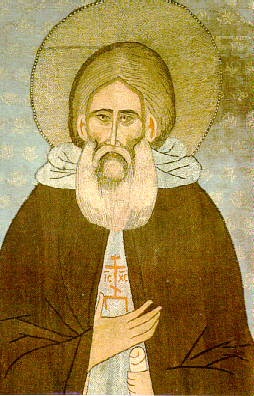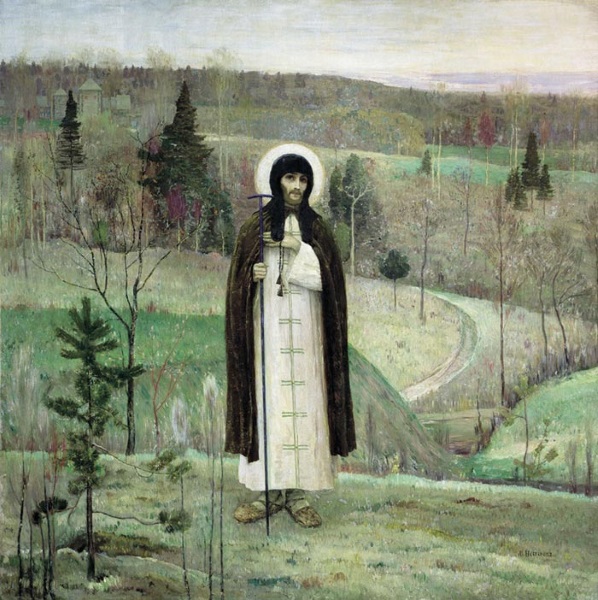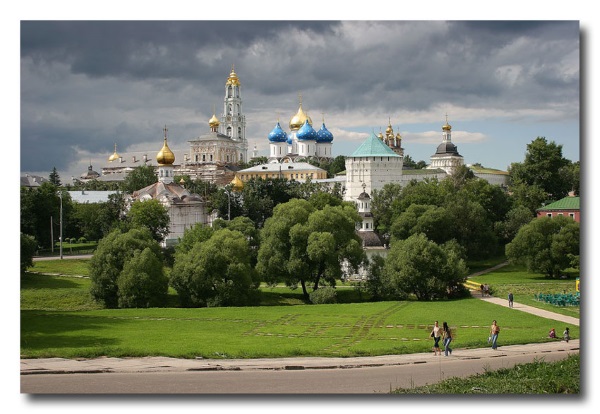
St. Sergius of Radonezh is commemorated by the Russian Orthodox Church twice a year: July 18 and October 8. The exact birth date of Sergius, the greatest saint of ancient Rus, in the opinion of Russian philosopher Georgy Fedotov, is unknown. And while a majority of historians agree on the year 1314 – though some arguments exist in favor of 1318 and other years – the month and date remain obscure. Sergius (his secular name was Bartholomew) was baptized on June 11, on the day of his heavenly patron.
And because babies were baptized on the fortieth day after their birth in those times, it is not hard to count that he was born on May 3. Accordingly, the “peaks” of official celebrations fall on May, July and October. Thus, consecrated on May 11 this year was a new cathedral in Trinity-Varnitsky Monastery which is thought to be set up on the site of the future Saint’s parental estate, where he was brought up by his father Cyril and his mother Maria. A couple of days later a major exhibition was opened in the State Historical Museum, devoted to Reverend Sergius as the founder of the Trinity Lavra of St. Sergius. Among the exhibits is a rather hefty grant-charter by Empress Elizaveta Petrovna, dated 1744, raising the monastery on Makovets to this elevated status.
The exhibition is eloquent, revealing and full of relics. On display practically for the first time is a huge colored lithograph representing a sacred procession from Krestovskaya Barrier to Makovets. Everything is distinguishable there – from individual faces to recognizable edifices – on this oldest pilgrimage route in Rus. But for all our respect for the rarities displayed, we should note that almost everything there (save for the saint’s prayer book) was somehow originated from or inspired by Sergius.

And Sergius himself… Surely it’s now a lot easier for us to judge about him from the perspective of seven centuries past, this huge seven-tier belfry, so to say. From this height we can see quite well that the hermit from Makovets was the first so-called nation-forming personality in Russia. This phenomenon was first defined by well-known journalist and publisher Alexei Suvorin in his diary little more than 100 years ago, when he said: “We have two czars – Nicholas II and Leo Tolstoy…” Unlike Europe, however, in Russia this status excludes high posts in political, ecclesiastical and other hierarchies: Sergius repeatedly refused becoming the heir to metropolitan Alexis of Moscow. Alas, nowadays we do not have personalities of this scope in Russia, the last being Andrei Sakharov, Dmitry Likhachev and Alexander Solzhenitsyn.
Any jubilee is an undisputable occasion to correlate its subject to oneself and to the condition of the society that celebrates it. What I treasure most in Sergius is his staggering inner freedom, especially for those medieval times.
Both towards the powers that be and towards people of the lowest social standing: “Never bend the mind or your neck to livery, or power or office…” And in the 14th century rulers were much more hot-tempered and quicker to clean house than in Pushkin’s times and especially nowadays. The most passionate man of that epoch, Prince Oleg Ryazansky, was worth many others. Sergius was able to calm this tempestuous man with quiet words alone. And how many tempestuous Olegs of less renown crossed his path in life?
Or take his “plainness without garishness”, as ecclesiastical folks put it. Many remember, of course, that Sergius as an abbot nevertheless performed all chores done by monks. Not many are aware of the fact that until his old age the Reverend did not use a horse in his travels on the premise that this unlawfully raises him above those around. Thus he walked to Ryazan over the muddy roads.
…Exactly on the day of the former jubilee or rather the birthday of Sergius, May 3, I came to his lavra. There was no particular crowding, just a usual tourist day with big busses strewn around the monastery walls, with a line of people waiting to worship the Holy relic, as is the custom. As the classic put it, “the line wasn’t excessively long – about 150 people.” Slightly more than a half of those, who I managed to talk to on the run, had different ideas of what Reverend Sergius meant for our nationhood. The rest, sincerely or not, answered in the spirit of the formula from the popular film: “Everybody came running and I joined the crowd.” Or simply: “I am a Russian Orthodox person, that’s why I am here.”

And then the crowd ebbed. The lower the sun is and the fewer idle folks hang about in the lavra, the easier one can understand the feelings of Anna Akhmatova who late in life described it as the best place in the world. And it’s very easy to imagine not a modest, skinny and graying man walking here on the previous “grand” jubilee of St. Sergius (the 500th anniversary of his repose) towards the Ecclesiastical Academy where he, Vasily Klyuchevsky, was to deliver one of his best public speeches about the significance of Sergius of Radonezh in the history of Russian people and statehood. “Ask any of these common people… when St. Sergius lived… what he meant for his epoch and very few of us would give a satisfactory answer; but to the question what he means to them, distant descendants of the people living in the 14th century, and why they have come to worship him, each will give a firm and intelligible answer.”
Looks similar? Both yes and no! Hardly anybody of our contemporaries can imagine Makovets at the time, when Bartholomew-Sergius came there, although the very mount is still very well visible in the surrounding terrain. It’s even harder to imagine that the nearest inhabited locality, Radonezh, then lied 15 verst (!) away from Makovets and the only thing that sadly brings the two epochs together is prevalence of the “jungle” at this site both in the 14th and in the 21st centuries – then the natural forest, now the stone jungle. The population of today’s Sergiev Posad exceeds 100,000 people, but little is left from the city seen even by Klyuchevsky, except the monastery and its nearest surroundings.
It may seem that little has changed since the late 19th century inside the abode. All buildings have remained intact. The reborn Tsar Bell, one of the largest in Russia, is hanging in an honorable place on the belfry. And the same line of people is standing in front of the saint’s sepulcher. It appears as though there had been no outrage, no blasphemous unsealing of the Holy Relic accompanied by the filming meant for the Bolshevist upper crust, no wild reprisal against the ancient bells which were smashed with axes and hammers, no teachers training institute and atheistic museum in the buildings prayed-in for ages.
Vasily Klyuchevsky was not aware that the final words in his speech would be prophetic: “Commemorating St. Sergius, we prove ourselves, review our moral foundations willed to us by the great builders of our moral order, renew it, making up for losses. The gates of St. Sergius’ monastery will close and the lampions over his sepulcher will go out only if we squander totally this stock away without replenishing it.”
And each who enters the territory of the lavra nowadays must answer the question: could we replenish the moral stock referred to by the great historian and to what extent? Answer this question based on the widely known traits of Saint Sergius, your knowledge of the Russian history and finally your life experience. For there’s no escaping the fact that craving for the spiritual authority and mentor who would resemble at least to some degree St. Sergius of Radonezh shines through glamorous speeches, choirs and orchestras both among the laity and clergy. Will such person appear in the foreseeable future? In the words of Chekhov’s character, “if only we knew”!
Georgy Osipov

 St. Sergius of Radonezh is commemorated by the Russian Orthodox Church twice a year: July 18 and October 8. The exact birth date of Sergius, the greatest saint of ancient Rus, in the opinion of Russian philosopher Georgy Fedotov, is unknown. And while a majority of historians agree on the year 1314 – though some arguments exist in favor of 1318 and other years – the month and date remain obscure. Sergius (his secular name was Bartholomew) was baptized on June 11, on the day of his heavenly patron.
St. Sergius of Radonezh is commemorated by the Russian Orthodox Church twice a year: July 18 and October 8. The exact birth date of Sergius, the greatest saint of ancient Rus, in the opinion of Russian philosopher Georgy Fedotov, is unknown. And while a majority of historians agree on the year 1314 – though some arguments exist in favor of 1318 and other years – the month and date remain obscure. Sergius (his secular name was Bartholomew) was baptized on June 11, on the day of his heavenly patron. And Sergius himself… Surely it’s now a lot easier for us to judge about him from the perspective of seven centuries past, this huge seven-tier belfry, so to say. From this height we can see quite well that the hermit from Makovets was the first so-called nation-forming personality in Russia. This phenomenon was first defined by well-known journalist and publisher Alexei Suvorin in his diary little more than 100 years ago, when he said: “We have two czars – Nicholas II and Leo Tolstoy…” Unlike Europe, however, in Russia this status excludes high posts in political, ecclesiastical and other hierarchies: Sergius repeatedly refused becoming the heir to metropolitan Alexis of Moscow. Alas, nowadays we do not have personalities of this scope in Russia, the last being Andrei Sakharov, Dmitry Likhachev and Alexander Solzhenitsyn.
And Sergius himself… Surely it’s now a lot easier for us to judge about him from the perspective of seven centuries past, this huge seven-tier belfry, so to say. From this height we can see quite well that the hermit from Makovets was the first so-called nation-forming personality in Russia. This phenomenon was first defined by well-known journalist and publisher Alexei Suvorin in his diary little more than 100 years ago, when he said: “We have two czars – Nicholas II and Leo Tolstoy…” Unlike Europe, however, in Russia this status excludes high posts in political, ecclesiastical and other hierarchies: Sergius repeatedly refused becoming the heir to metropolitan Alexis of Moscow. Alas, nowadays we do not have personalities of this scope in Russia, the last being Andrei Sakharov, Dmitry Likhachev and Alexander Solzhenitsyn. And then the crowd ebbed. The lower the sun is and the fewer idle folks hang about in the lavra, the easier one can understand the feelings of Anna Akhmatova who late in life described it as the best place in the world. And it’s very easy to imagine not a modest, skinny and graying man walking here on the previous “grand” jubilee of St. Sergius (the 500th anniversary of his repose) towards the Ecclesiastical Academy where he, Vasily Klyuchevsky, was to deliver one of his best public speeches about the significance of Sergius of Radonezh in the history of Russian people and statehood. “Ask any of these common people… when St. Sergius lived… what he meant for his epoch and very few of us would give a satisfactory answer; but to the question what he means to them, distant descendants of the people living in the 14th century, and why they have come to worship him, each will give a firm and intelligible answer.”
And then the crowd ebbed. The lower the sun is and the fewer idle folks hang about in the lavra, the easier one can understand the feelings of Anna Akhmatova who late in life described it as the best place in the world. And it’s very easy to imagine not a modest, skinny and graying man walking here on the previous “grand” jubilee of St. Sergius (the 500th anniversary of his repose) towards the Ecclesiastical Academy where he, Vasily Klyuchevsky, was to deliver one of his best public speeches about the significance of Sergius of Radonezh in the history of Russian people and statehood. “Ask any of these common people… when St. Sergius lived… what he meant for his epoch and very few of us would give a satisfactory answer; but to the question what he means to them, distant descendants of the people living in the 14th century, and why they have come to worship him, each will give a firm and intelligible answer.” 





